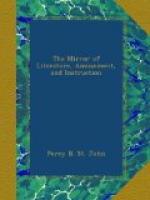a Gothic church, and celebrated for its excellent ale;
Clackmannan, a miserable town, where in a tower lived
King Robert Bruce, and where an old Jacobite lady
knighted Burns with a sword which belonged to Bruce,
observing that she had a better right to do so than
some folk; Falkirk, known for its
trysts,
or markets, where the country-people point out a battle-field,
and a stream called the Red Burn, from its running
with blood on the day of the conflict; Bruce lived
near this spot, the view from which he said was not
surpassed by any he had seen in his travels:
next lies the Firth of Forth, and the country as far
as Edinburgh and the Pentland Hills. Towards the
south stands the ancient village of St. Ninian’s,
and Bannockburn, the battleground of the most celebrated
and important contest that ever took place between
English and Scots; the Torwood, where till lately stood
a tree said to have sheltered Wallace; and the Carron,
bounded by the green hills of Campsie. Towards
the west are the plains of Menteith, a district, says
Chambers, distinguished almost above all the rest of
Scotland, for the singular series of beautiful and
romantic scenes which it presents to the view of the
traveller, and bounded by the majestic Grampians.
On the north are the famous ruins of Cambuskenneth,
and the precipitous Abbey Craig, beyond which lies
the richly-cultivated vale of Devon; the moor on which
the battle of Dumblain was fought; and Ochill Hills,
clothed with blooming heath, and overtopped by the
summits of Perthshire. Such is the artist’s
outline of the prospect: our task shall be to
select a few of its most entertaining details.
To return to the Panoramic arrangement: next
the castle is Gowlan Hill, the ordinary place of execution
in times of wicked bloodshed, and thus apostrophized
by Douglas, in the Lady of the Lake:
And thou O sad and fatal mound!
That oft hast heard the death-axe sound,
As on the noblest of the land,
Fell the stern headsman’s bloody
hand.
The hill has, however, less terrible association;
it being after called Hurly Hacket, from James V.
and his nobles there playing at that game, which consisted
in sliding down the steep banks on an inverted cutty
stool. This was, at least, more rational than
cutting off heads. Next is Abbey Craig, a rock
upon which Wallace defeated the English; Dollava, a
village on a gloomy rock, almost insulated by two streams,
whose Celtic names signify the glens of care and the
burns of sorrow; Tillabody, the birthplace and property
of Sir Ralph Abercrombie; the crumbling walls and
bell tower of Cambuskenneth Abbey, wherein several
parliaments were held, and at whose high altar the
clergy and nobles swore fealty to Robert and David
Bruce; Edinburgh, with its castle, thirty-eight miles
from Stirling, whence it is discernable in clear weather;
the Carron Iron-works; and the Carron, of more classic
celebrity in Ossian, and the battles of the Romans




